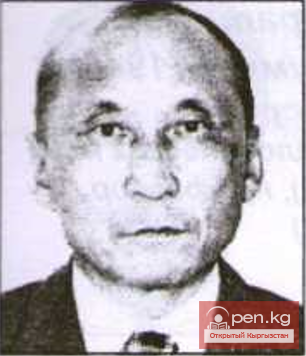Leather.
From the leather and hides of domestic and wild animals - horses, cows, camels, yaks, sheep, goats, foxes, martens, otters, mountain goats, and roe deer (Aitbaev, Ivanov, 1968, pp. 123-131) clothing was made (men's outer fur coats, hats, belts for elderly women, open skirts), footwear, dishes, household items, and horse harnesses. Lambskins (korne) were most often used for clothing. At home, the leather was cleaned, dyed, tanned, softened by hand or on a leather softener (talkuu), and dyed with plant dyes (Burkovsky, 1957, pp. 75-86; Antipina, 1962, pp. 127, 128). Rich hats were made from the skins of martens and otters; strips of fur from these animals were used to trim not only clothing but also to outline embroidered wall carpets. From the hides of sheep, goats, mountain goats, and roe deer, suede was made, which was highly valued for its qualities. "Kyrgyz people extraordinarily value the leather of kiyika because it is used to make the most durable and waterproof chombars" (Markov, 1901, p. 144). V. V. Vereshchagin depicted a hunter in a magnificently decorated chombar in his painting "Rich Kyrgyz Hunter with a Falcon" (1874), and the artist also captured the everyday life of the Kyrgyz in numerous sketches from nature (clothing, horse decoration, interior decoration of yurts, etc.).
Almost all parts of the processed animal carcasses were used in the household. Goat skins were made into utility bags and bellows for blacksmithing. Hides taken whole from calves, lambs, and kids were used as small bags (tulup) for storing tea, yarn, various utensils, and products. From the hides of calves and foals, utility bags for wooden dishes were sewn, as well as tablecloths for kneading dough (supra). Anchor-shaped vessels (kookor), variously shaped buckets (konyok, konyk) for kumys were made from the skin taken from the hump of a camel. From the udder, containers for dairy products were sewn, animal fat was stored in cleaned stomachs, and strings for the komuz were made from twisted intestines on a spindle. Snuffboxes, powder flasks, stamping pads, and bullet molds were carved from horn. Underlay mats (koldolyon, posten) were made from a single whole hide or sewn from different colors, forming patterns of squares, triangles, and highlighting the border.
Leather products are particularly diverse among the northern Kyrgyz; in the south, leather dishes gradually began to be supplemented with imported porcelain and metal from the late 19th century. Leather dishes (kookor, konyk) were made and decorated with embossed patterns mainly by women. All other products, such as harnesses, household mats, leather chests, and various cases for porcelain dishes, were made by men.
The processing of hides and leathers was done in summer using a sharp knife and a pointed stick; when sewing, tendon threads and horsehair were used. Leather vessels and bags were smoked in pits dug in the ground (yshtyk, ystady). Products were decorated with embossing, appliqué from colored leather or fabric, stitching with colored threads, metal ribbons, attached metal plates or sheets, decorative nails with heads, and patterns applied by stamping (Aitbaev, Ivanov, 1968, pp. 125, 126).
Leather cases for transporting dishes, mainly porcelain bowls and teapots, were previously widespread among the peoples of Central Asia and Kazakhstan, including the Kyrgyz, and their names are similar throughout the region: "serkesh" (Turkmen); "terkesh" (Uzbek and Kazakh); "chinni kap" (Uzbek); "shyny kap" (Kazakh, Karakalpak); "chyny kap" or "piala kap" (Kyrgyz), "kalmak bash" (Kazakh, Kyrgyz). The cases were decorated with inlays of silver, bone, horn, and colored leather. Nowadays, professional masters of artistic leather processing have emerged, creating various souvenirs, boxes, and bags.
Leather products are particularly diverse among the northern Kyrgyz; in the south, leather dishes gradually began to be supplemented with imported porcelain and metal from the late 19th century. Leather dishes (kookor, konyk) were made and decorated with embossed patterns mainly by women. All other products, such as harnesses, household mats, leather chests, and various cases for porcelain dishes, were made by men.
The processing of hides and leathers was done in summer using a sharp knife and a pointed stick; when sewing, tendon threads and horsehair were used. Leather vessels and bags were smoked in pits dug in the ground (yshtyk, ystady). Products were decorated with embossing, appliqué from colored leather or fabric, stitching with colored threads, metal ribbons, attached metal plates or sheets, decorative nails with heads, and patterns applied by stamping (Aitbaev, Ivanov, 1968, pp. 125, 126).
Leather cases for transporting dishes, mainly porcelain bowls and teapots, were previously widespread among the peoples of Central Asia and Kazakhstan, including the Kyrgyz, and their names are similar throughout the region: "serkesh" (Turkmen); "terkesh" (Uzbek and Kazakh); "chinni kap" (Uzbek); "shyny kap" (Kazakh, Karakalpak); "chyny kap" or "piala kap" (Kyrgyz), "kalmak bash" (Kazakh, Kyrgyz). The cases were decorated with inlays of silver, bone, horn, and colored leather. Nowadays, professional masters of artistic leather processing have emerged, creating various souvenirs, boxes, and bags.
Decorative and Applied Art
















































